If you are here for the Anki Guide skip to Here.
What content do you remember from your last exam? How about the author of the last book you read? What did you eat for lunch on Thursday two weeks ago? Can’t remember? Me neither.
Our brain is constantly barraged with information, so it needs to be very good at clearing out the unnecessary junk. What you had for lunch two weeks ago, your brain decided (rightly so), wasn’t essential information.
That information is not stored; it’s deleted. Gone. There is no recovering it from the trash.
But what if you need to remember something important? Like the 6-digit number code to your phone, or (if you’re a medical student like me) the treatment for an ST-elevation myocardial infarction?
In regards to your phone, you always know the code. You didn’t study that information, right? If I asked you it right now, you would be able to tell me easily. You know your phone code cold because you are constantly testing yourself on that piece of information. Without realizing it you are practicing spaced repetition.
However, to remember the treatment for an ST-elevation myocardial infarction (or STEMI) I need to study that. If I don’t test myself regularly on that information I won’t remember it very long.
Studies show, that we forget around 67% of the information we learned within a 48 hour period. That’s not good. So how do we fix that?
The best answer I have found is spaced repetition.
Active recall, practice testing, and spaced repetition have made the biggest improvements to my studying since I started medical school a year ago.
Evidence
The first time we study something we forget it very quickly. The next time we study that same thing we forget that piece of information a little less quickly, and the next time even less quickly, and so on until you can actually remember something for quite a long period of time.
Take a look at this graph (thanks to senseandsensation.com)

In 1880, someone named Ebbinghaus named this idea the “forgetting curve.” Now it is important to realize that many other factors come into play when it comes to memory such as your senses and emotion. However, when we have to remember boring facts (i.e. Ebbinghaus made his subject memorize nonsense words such as “ZUC” and “QAX”), our memory will likely fall along the above curve.
This experiment has been repeated and, in the paper, I looked at from 2015, had similar metrics.1
So how do we beat the forgetting curve? Well, we just test ourselves on that information, right before we fall off that curve. As shown in the green lines here.

If we test ourselves we return to the top of the memory percentage. But when do we test ourselves?
Is the spacing of this testing important (as it seems by the graph above is that it is not) or can we just test ourselves on the same topics once every week, or once every three days?
The evidence shows that reviewing at steady intervals is not as effective as reviewing at expanding intervals.3
One experiment took 250 students and had them study 60 physiology concepts. One set of students reviewed the 60 concepts at a fixed interval (i.e. at 1, 10, and 20 days post-learning it) and another set of students reviewed the 60 concepts at expanding intervals (i.e. at 1, 6, 16 days). Finally, one group didn’t do any recall practice at all. So the two experimental groups both reviewed the 60 pieces of information the same amount of time but just at different intervals.
All groups then took a final test at day 29. Who did the best?

Students who used the expanding interval scored 14% greater than the students with the fixed interval and 36% greater than the students who did nothing at all; the students who used expanding intervals approximately doubled the score of those that did no recall practice at all.
A Yale review article on study techniques for medical students stated:
Whenever students learn factual knowledge, they should test themselves while learning, actively recall information, and retest the facts at expanding time intervals to make learning in medical school most effective. These learning strategies help students learn the most in the least amount of time.
Marc Augustin4
To learn effectively use active recall, practice testing, and spaced repetition.
The statement that really stood out to me was, these learning strategies help students learn the most in the least amount of time.
In summary, the forgetting curve means we will inevitably forget something we learn that day. Active recall and spaced repetition can save us from falling off this curve, and significantly improve our content retention in the long term.
Implementation
Spaced repetition is important. I think we have established that, but how do we actually implement spaced repetition? How do you know when you should practice certain information? One day after you learn it? Two Days? A week?
An expanding interval seems to be supported by evidence the most, but how can we calculate it? How can we find the perfect amount of days between study sessions?
Luckily, the cliche term holds true, there is an app for that.
That app is Anki.
There are other methods out there such as Quizlet, excel sheets, and physical flashcards but, in my experience, Anki is the best.
Anki is an electronic flashcards that implement this time spacing via a specially crafted algorithm. It also syncs on my phone, computer, and iPad.
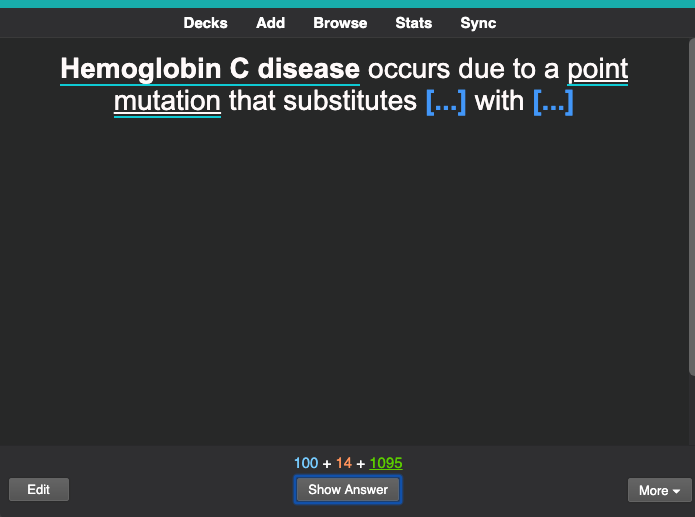
This is how it works, you do a question and try and answer that question in your head. Then you hit the spacebar. If you got it right you select an answer based on how easily the answer came to you.
So, for example, I got this question right, but it was hard, so I would select “hard.” That means I would be tested on this same flashcard in 3.2 months.
Anki has estimated when, for that piece of information, I will fall off that forgetting curve and forget that piece of information (3.2 months), so it will test me again at that point so I don’t continue to lose retention of that key piece of information.
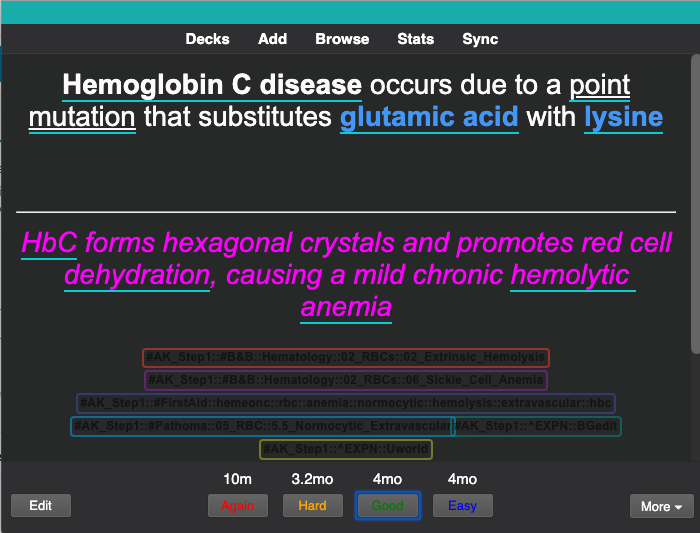
If I didn’t know the answer, I would select “again” and then I would have to answer that question again in 10 minutes.
Now you don’t have to use this for retaining medical knowledge, that’s just how I use it. I know many people that use it for language, or other courses, with the same great results.
If you want to see how I set up my Anki, and my workflow, keep reading. Otherwise, I would just skip to the summary.
My Anki Setup for Medical School
Warning: This is a lot of information and you may feel overwhelmed. Don’t worry, take it slow. Follow this guide by maybe doing step 1, then leaving it for the day. Come back tomorrow and do step 2, and so on.
It took me 2 months to get a basic level understanding of Anki and begin to use it effectively.
Getting to know how to use Anki is tough, but it is 100% worth it in the end. (At least in my experience)
**Update (09/15/2021): AnKing V10 is out! I have updated the links accordingly below (previously links to V7)**
I recommend using V10 over V7. V10 includes various updates making the update worth it, follow this link and read it carefully before updating: Link to AnKing V10 Post
The great thing about Anki, for medical school, is that there are many high quality premade decks out there with all the information you will need for Step 1 (pretty much). I personally use the Anking V7 Deck (I just updated it to V10). This is a great deck made by “The Anking” and a guide on how to get started on it is on Reddit. Shout out to the Anking! He also has a youtube channel.
So how can you get your Anki set up exactly like mine and retaining information? Follow these steps. Or go to my YouTube video and skip to time 02:16.
- Go to this Reddit post, and follow all the instructions, watch the videos, it will make your life easier.
- Download the addons from this page
- Special Fields
- Customize Sidebar
- Image Occlusion Enhanced for Anki 21
- True Retention
- Hierarchical tags
- Review Heatmap
- Restart Anki and Copy all of my settings in the pictures here. The first two images are in preferences, the second set of images is from my settings (the little gear icon next to your deck). I go through all the justifications for the settings in my video.
***UPDATE: I RECOMMEND DIFFERENT SETTINGS FOR MEDICAL SCHOOL, AS SUCH I HAVE REMOVED THE SETTINGS FROM THIS POST. INSTEAD, GO TO THIS POST HERE AND USE THOSE SETTINGS.
4. Go to the bottom and click “Create Deck,” make two new decks: One called Incorrects and another called Lecture Specific.
The incorrects deck I put self-made cards on every question I get wrong from a usmle Step 1 Resource. Here is a good guide on making your own cards.
The lecture specific deck I put any cards that might be relevant for my upcoming exam whether it be anatomy or something else that is not as relevant for Step 1. There are a bunch of great pre-made decks that can be found on the medical school anki subreddit. The reason I have this deck separate is that after I finish an exam I might not think that information will be that relevant for later on so I re-suspend those cards (disabling them). If I think the cards are worthwhile remembering, simple, I just go to browse and move them into my “Anking” deck.
So now you should have three decks that look like this. (Mine is in dark mode if you followed the settings guide above and have the most recent version of Anki downloaded, with my settings, yours should look like this too!)
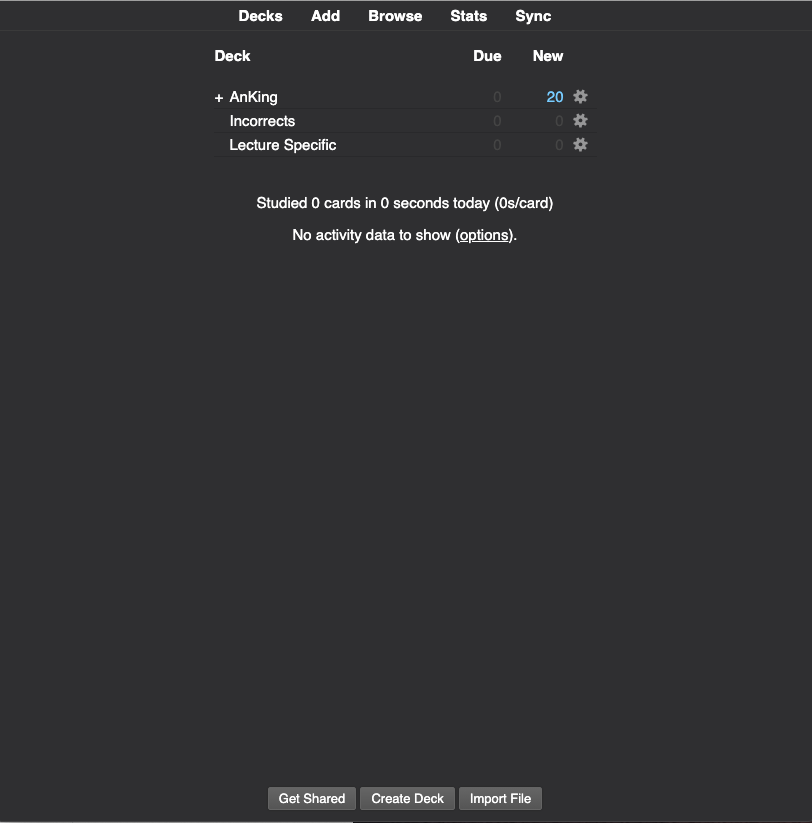
4. Go to Browse, this should come up. If the sidebar on the left doesn’t look right you haven’t downloaded the addons properly on step 2.
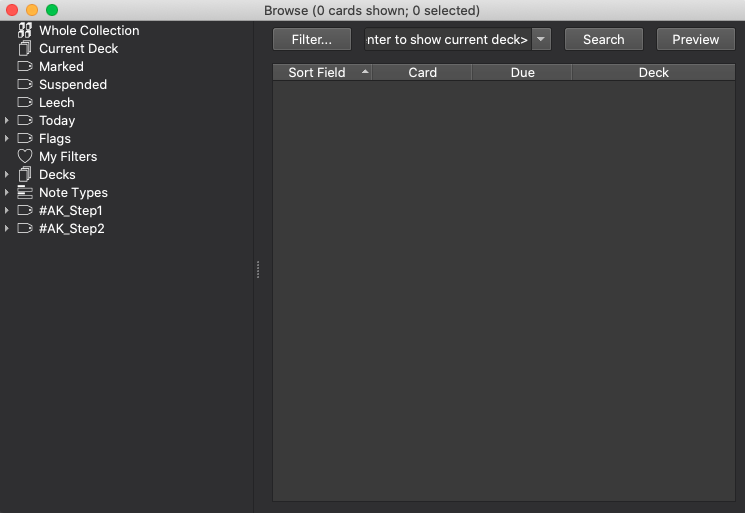
5. On the Left Click, the little arrow next to Decks then click Anking. Hit command-A (select all hotkey) then Command-J (Suspend hotkey). It should now look like this.
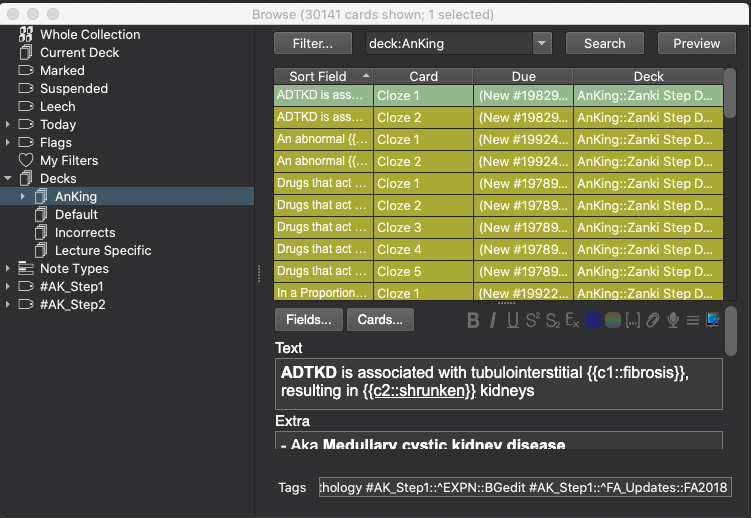
There! You are pretty much done! The next step is actually using all of this amazing stuff.
My workflow below is for when you actually have some cards to do. If you followed all my steps all of your cards are suspended. So they are effectively disabled. What you want to do is, after you learn something, enable (un-suspend by hitting command-J) all of the relevant flash cards.
The great thing is, if you followed my steps and the Anking’s guide, it is really easy to do.
If you go to browse -> #AK_Step1 you can see every topic broken down, so go in, unsuspend some cards (with command J), and try it out!
My Anki Workflow in Medical School
Every morning, after I do my morning routine, I get right to this workflow.
- Do all the cards I have due to review
- Watch the relevant video topic (such as pathoma video 1.1)
- Go to the Pathoma 1.1 subfolder in Anki and unsuspend (command A -> command J) all the pathoma 1.1 cards
- Look over all the cards in the browse section to make sure I understand each card. If I don’t I will look up the information online until it makes sense to me and maybe put in a few edits.
- Study those new cards!
That is my Anki workflow and, depending on the day, usually takes around 3 – 5 hours (using the Pomodoro Method). It can be taxing, I often wake up at night dreaming about flashcards. I think my struggling now will pay off in the long-term though. The evidence and stories from other medical students all points to the same thing: if I am consistent with my active recall, practice testing, and spaced repetition I will do well.
Of course, there is usually other stuff to do in the day such as school lectures, practice questions, and other misc content but the one essential thing I do, the one thing I make sure I do NO MATTER WHAT is get through that workflow. Gretchin Rubin, a productivity writer says
What you do every day matters more than what you do once in a while
Gretchin Rubin
It’s a fairly simple quote, but one that, I think, is really important. That’s why I do my Anki every day and try to be a better medical student every day. That’s also why I am writing blog posts and working on youtube videos every day. Because that’s what is important to me and what I want to excel at. It’s what matters to me.
Summary
Without purposeful learning, we will forget what we learn.
Spaced repetition helps us retain more information by testing us at the time just before we start to fall off the forgetting curve.
Anki automates the spaced repetition timeline, and, therefore, long-term knowledge of whatever subject you are learning.
Thanks for reading! I hope this was helpful, I know when I was starting medical school I heard about Anki and just had no idea how to get started. Hopefully this helped, even if only a little bit.
Work Cited
- Murre JM, Dros J. Replication and Analysis of Ebbinghaus’ Forgetting Curve. PLoS One. 2015;10(7):e0120644. Published 2015 Jul 6. doi:10.1371/journal.pone.0120644
- Roozendaal B, McGaugh JL. Memory modulation. Behav Neurosci. 2011;125(6):797‐824. doi:10.1037/a0026187
- Dobson JL. Effect of uniform versus expanding retrieval practice on the recall of physiology information. Adv Physiol Educ. 2012;36(1):6‐12. doi:10.1152/advan.00090.2011
- Augustin M. How to learn effectively in medical school: test yourself, learn actively, and repeat in intervals. Yale J Biol Med. 2014;87(2):207‐212. Published 2014 Jun 6.

11 comments
Marki
Hello! Thanks for all you do, you are obviously amazing. I was just wondering about the Anking V12. Looks like since this article was published v10 no longer is available and I can’t seem to work this out exactly like you have it here. Any tips would be lovely. Muchas Gracias!
Zach
Use v11! I’ll update it now.
Jasmin
One of the codes doesn’t work and unfortunately I couldn’t find the code for checking the heat map. Otherwise great! Thanks for your tips!
Seyram
Hey Zach,
I really like this post. My only problem is I’m a humanities freshman but a lot of research I’ve done on Anki seems to show relevance for the medical community. I’m not saying medical school is easy or looking down on anyone; but if you can please find out and reference me to a humanities student preferably reading Economics or Geography, it’ll be a great help. Thanks.
PS: As an avid reader, I must say I’m impressed with your reading list 😘. Very classy 😅😎😉😁
Lisa
Hi Zach,
I’ve just discovered your YouTube channel and had to subscribe and share ! it is so informative and very easy to understand and listen to , also, this explanation of using Anki is super helpful! but I only have 3 weals until my final Medical exams – not sure if this method would be helpful or have any effect? I work best with flash cards but of course with only 3 weeks I’m not sure if spaced repetition can be done?
Any advice on this would be great!
Lisa 🙂
Lisa
Zach
I would say it can work for sure! Just don’t do a crazy amount of flash cards and only create/use the highest yield ones you can find.
-Zach
Marcos Valencia
Hi Zach! That was a really cool guide! You helped me to understand a little bit more about Anki and how to use Anking 🙂
I just got one question, once you unsuspend one sub folder, you keep it unsuspended until you reach the “review” state for each card? Or do you resuspend it once you finished your day?
I mean, for example I am going to start using Anking. So if unsuspend, lets say, Gram positive cocci, then I do my study session and those card will appear again the next day to me according to the anki algorithm. Then the next day I want to study gram negative cocci so I go and unsuspend those, then start studying the new cards. But I must suspend again the gram positive ones or should I just not suspend them and let the anki algorithm make its work ?
sorry, im a total noob with this 🙁 haha and I cant imagine how I’m I going to start studying with this awesome deck
Thankyou for you time man! Greetings from Mexico 🙂
Zach
Hey Marcos,
You have the first comment on my website! Just wanted to point that out, now to answer the question:
It really depends on what you are studying for, if you want to retain that information in the long-term (which gram+/gram- cocci probably means yes) DO NOT resuspend those cards. Just leave them unsuspended and let the Anki algorithm work its magic.
I have a post on my daily study routine, how I study from the AnKing deck every day, here if you want to check it out: https://zhighley.com/the-best-daily-workflow-for-medical-school-what-works/.
You are welcome!